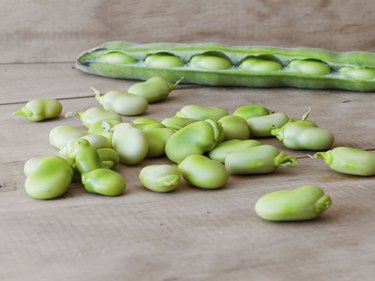
Butter beans, also known as lima beans, cook up to a creamy textured, rich-tasting bean and is common in Southern cuisine. While some farmers' markets or grocery stores may sell the beans already shelled, butter beans come in pods that need to be removed prior to cooking. Cook fresh butter beans thoroughly before eating them as they are not safe to eat raw; they contain cyanide, which is a poison. The cyanide is neutralized and destroyed when the beans are cooked.
Picking and Cleaning Butter Beans
Video of the Day
Butter beans that need to be shelled most commonly are harvested while the shell is still green but the beans are fully mature. In some cases, the beans are left to mature and dry on the vine, but these beans come already shelled in grocery stores and markets. Choose large, unblemished, pale-green pods. Pods that have discoloration or have become soft and mushy have started to rot, and it is likely the beans inside have begun to spoil.
Video of the Day
Shelling the Beans
To shell a butter bean, hold the bean pod with both hands with your thumbs along the inwardly curved, ridged crease of the bean. Press gently onto the ridge and it will split open, revealing flat, broad beans attached to either half. Carefully remove these beans, place them in a bowl and discard the shell. Repeat the process until all beans have been shelled. Rinse the beans to clean off any dirt and store them in a sealed container in the fridge until you are ready to cook them.
Cooking Shelled Butter Beans
Fresh butter beans cook more quickly than dried ones, largely because there is no soaking time required. Simmer fresh butter beans in liquid -- stock, water or wine -- to soften and cook the beans. Never boil the beans as this can cause them to break down and turn mealy. Adding some fat such as from bacon or smoked ham provides depth of flavor as well as extra richness. When fully cooked, fresh butter beans have a silky, creamy texture that pairs well with rich, flavorful sauces. While acidic ingredients such as tomato sauce or lemon juice can help cut the richness of the beans and brighten the flavor of a dish, add them only at the very end. Too early and they can cause the skin of the beans to thicken, taking longer for them to cook.
Storing Butter Beans
Cooked or freshly shelled butter beans can be stored in the refrigerator in a sealed container for upward of five days. If you need to store freshly shelled beans for longer, blanch them and freeze them in freezer-safe bags. Stored correctly, they can last upward of two to three months in the freezer.